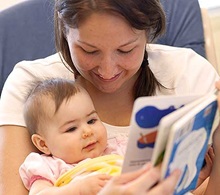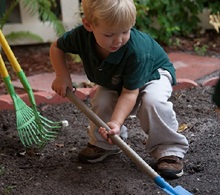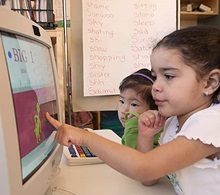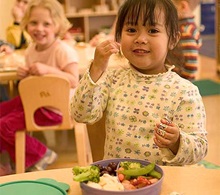 Reading to infants contributes to the development of their growing brains and gives them a good start towards a lifelong love of reading and good literature. When you read to babies, it can also help speech development as they are taking in information and beginning to learn about speech patterns. In addition, synapses connect between your infant’s neurons as you read aloud, positively affecting child development in many areas.
Reading to infants contributes to the development of their growing brains and gives them a good start towards a lifelong love of reading and good literature. When you read to babies, it can also help speech development as they are taking in information and beginning to learn about speech patterns. In addition, synapses connect between your infant’s neurons as you read aloud, positively affecting child development in many areas.
Infants tune in to the rhythm and cadence of our voices, especially the familiar voices of their parents and caregivers. While initially the rhythmic phrase, “Brown bear, brown bear, what do you see?”, for example, may not hold meaning, your baby is taking in the sounds of language and how they fit together. As babies see a picture of a red bird in the book and you name the bird, they begin to make the connection between what you say and the picture of the red bird. The more you read that book, the stronger the connection. The repetitive storyline makes the book fun, engaging, and easier to remember. Reading to babies is not only a way to inspire a love of books from infancy, but also an important way to grow a baby’s vocabulary – first his understanding vocabulary and later her speaking vocabulary.
Best Way to Read to Your Baby
- Of course reading aloud to an infant is different than reading aloud to a preschooler. With a baby, you may not get through the whole book. Your baby may want to hold the book and chew on it or try turning pages. All of these actions are appropriate and help your child become familiar with books and how to handle them.
- Make reading together a close cuddly time. Reading before bed may be the perfect time to hold your baby on your lap and cuddle together while you read.
- Don’t worry about reading a book start to finish. It is great if you can, but if your child wants to stop and hold or chew on the book, that is okay. That is another way infants take in information about their world.
- Point out and name pictures. Later ask your baby to find the “cow”, “horse”, etc., when you point to it.
- Increase the length and complexity of books as your child shows interest. By about one year of age, some babies will enjoy hearing a short book with a storyline.
How to Choose Books for Babies
Books for babies should be easy for them to hold and manipulate. Books in heavy cardboard (board books), cloth, plastic or even wood are popular and hold up to a baby’s use. Some recent favorites from the Growing Readers Books of Excellence and Notables include:
- Everyone Eats by Julio Kuo
- In the Garden by Elizabeth Spurr
- Little Mouse by Alison Murray
- Whose Toes are Those? by Sally Symes
- I Can Do It Myself by Stephen Krensky

 From infancy, humans seem to be on a quest for independence. Babies insist on holding a bottle or picking up food themselves. Toddlers emphatically announce, “Me do it.” The preschool years are a time of burgeoning independence as children gain the intellectual, verbal, and social-emotional skills to tackle more tasks independently.
From infancy, humans seem to be on a quest for independence. Babies insist on holding a bottle or picking up food themselves. Toddlers emphatically announce, “Me do it.” The preschool years are a time of burgeoning independence as children gain the intellectual, verbal, and social-emotional skills to tackle more tasks independently. When we become parents or if we’re planning to become parents, we develop our own concept of what the “right thing” is when it comes to parenting. We may opt to be the strict disciplinarian or maybe we’ll opt for being more relaxed and even care free and still others may opt for something more in the middle of both styles.
When we become parents or if we’re planning to become parents, we develop our own concept of what the “right thing” is when it comes to parenting. We may opt to be the strict disciplinarian or maybe we’ll opt for being more relaxed and even care free and still others may opt for something more in the middle of both styles. Smart phones, laptops and tablets, oh my! We love all sorts of technologies ourselves but worry about the effect of too much technology on our children. According to a study by Common Sense Media in 2013, the total
Smart phones, laptops and tablets, oh my! We love all sorts of technologies ourselves but worry about the effect of too much technology on our children. According to a study by Common Sense Media in 2013, the total  Sometimes difficult questions can take parents by surprise. It can be good to plan in advance on how and what to talk to your children about when they ask about death. It is critical not to avoid or try to brush off the questions as that will only cause more confusion and perhaps even fear if children pick up your discomfort on the subject. Here are some tips on how to talk to your children when they ask the difficult questions:
Sometimes difficult questions can take parents by surprise. It can be good to plan in advance on how and what to talk to your children about when they ask about death. It is critical not to avoid or try to brush off the questions as that will only cause more confusion and perhaps even fear if children pick up your discomfort on the subject. Here are some tips on how to talk to your children when they ask the difficult questions: Grocery shopping can be a tricky business, especially for those who are trying to shop healthier. However you can make smarter decisions when shopping by making use of a few tried and tested techniques.
Grocery shopping can be a tricky business, especially for those who are trying to shop healthier. However you can make smarter decisions when shopping by making use of a few tried and tested techniques. We’re well aware of the most common types of poisons that may be lurking in the cupboards in our homes:
We’re well aware of the most common types of poisons that may be lurking in the cupboards in our homes: One of the most common struggles parents have is dealing with picky eaters. Does any of this sound familiar to you?
One of the most common struggles parents have is dealing with picky eaters. Does any of this sound familiar to you? While as adults, we tend to enjoy our bedtime and welcome it with open arms, our children aren’t as excited when it comes time to sleepy time. Here are a few tips to help make the bedtime struggle with your little ones a little less of a struggle.
While as adults, we tend to enjoy our bedtime and welcome it with open arms, our children aren’t as excited when it comes time to sleepy time. Here are a few tips to help make the bedtime struggle with your little ones a little less of a struggle.